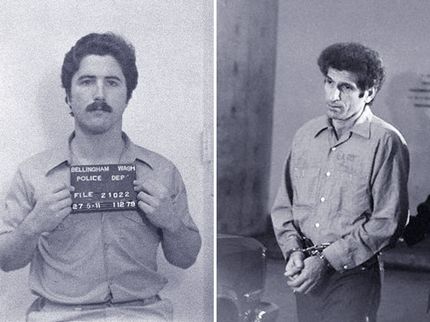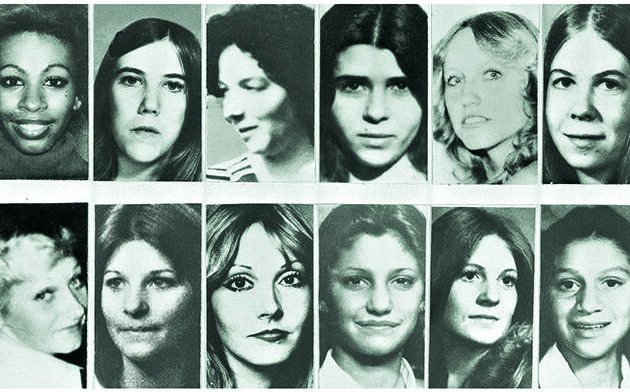
“If ever there was a case where the death penalty is appropriate, this is the case.”
The Hillside Strangler killings are among a rare class of murders that were perpetrated by a serial killer team: Kenneth Bianchi and Angelo Buono Jr. They also happened to be cousins.
Angelo Buono
The older Angelo Buono (born 1934) began to show deviancy during his adolescence. He was sexually curious in a manner abnormal for his young age. As a teenager Buono bragged about having already committed multiple sexual assaults. He even idolized “The Red Light Bandit” – a serial rapist. His penchant for stealing cars also landed him in reform school.
After his high school graduation, he married – only to leave his wife when he found out she was pregnant with their child. Buono would later marry again and father five more children before ending this second marriage in divorce also. When his second wife tried to reconcile, Buono handcuffed her and threatened her with a gun. He married a third time and fathered two more children – one of which he sexually assaulted. After this was discovered by his wife, Buono’s third marriage also ended in divorce. The following year, Buono entered a fourth marriage, though it appears they never lived together.
It was now the year 1975, and Buono continued to rack up violent criminal offenses: mostly auto theft and sexual assaults.
Kenneth Bianchi
Kenneth Bianchi was born in 1951 to a 17 year old prostitute who gave him up for adoption. As a child, Bianchi only once met the older Buono, who moved to California 12 years before Bianchi was born.
Though Bianchi’s adoptive parents by all accounts provided him with a good and loving home, Bianchi began to display abnormal and deviant behavior almost as soon as he learned to talk. He was a shameless and frequent liar. He was prone to fits of rage. Due to bed wetting that persisted beyond the age of 5 and trance-like daydreams, his mother began taking him to see both doctors and therapists. Bianchi scored above average on IQ tests and also received his first mental health diagnosis: passive aggressive personality disorder. The manifestations of this disorder vary, but include: antisocial features, sadistic features, stubbornness, superficial bravado, inability to experience emotion, indecisiveness, and lack of impulse control – many of which were displayed by Bianchi.
When Bianchi was 13, his adoptive father died. It was reported that Bianchi showed no emotion over his death. Like his cousin Buono, Bianchi married shortly after graduating high school, but the marriage failed 8 months later – his wife left him without explanation. Bianchi enrolled in community college with hopes of becoming a police officer, but dropped out after just one semester. For several months he struggled to hold down a job before securing a position as a security guard at a jewelry store – from which he began stealing. He would use the stolen loot to entice girlfriends and prostitutes.
Between the years 1971 and 1973, three girls ages 10 and 11 were murdered in Rochester, NY. The crimes were never officially solved though a few likely suspects were identified – one of which was Bianchi, who lived in Rochester until 1976.
Teaming Up
Through Bianchi’s mother, he reached out to his cousin Buono in California. Buono agreed to let Bianchi move in with him. Buono had two young runaways living with him who, through fear, he treated as sex slaves. Together Bianchi and Buono came up with the idea to act as pimps and sell them for sex. Eventually the two trafficked women were able to escape. During this time, Buono showed Bianchi how easy it was to coerce free sex from prostitutes by flashing a fake badge.
Wanting to keep their hustle going, the cousins approached a prostitute named Deborah about purchasing a “trick list”: a list of “Johns” – frequent customers of prostitution. When Deborah returned with the list of names (which turned out to be fake) she had another prostitute with her named Yolanda. Bianchi and Buono soon discovered they’d been sold a phony list and wanted revenge.
Unable to find Deborah, they instead tracked down Yolanda.
The First Murder
Bianchi and Buono located Yolanda outside a music store, flashed their fake badges, and soon had her handcuffed and inside their car. Her body was discovered bound on a California hillside. She had been strangled to death, her body deliberately posed. On October 18, 1977, the Hillside Strangler was born.
This would become the MO (modus operandi) for the majority of their subsequent murders: flash a phony badge, handcuff their victim, and then death by strangulation – often after brutal torture. Bianchi and Buono would end up killing 9 more women together. The pair didn’t wait long to kill again. Just two weeks later, another body of a murdered prostitute showed up – bound, strangled and discarded on a hillside. This time it was a 15 year old runaway.
Less than a week would pass before they would find a third victim: a 21 year old waitress and exotic dancer. She was last seen on the night of November 5th leaving the restaurant where she worked . Bianchi and Buono, posing as undercover police, pulled her car over as she drove home. After flashing their phony badges, she was “arrested” and taken in for “questioning.” She was instead taken to Buono’s auto upholstery shop and subjected to horrific abuse and then killed by strangulation. Her body was found the next day bearing the Hillside Stranger’s signature: bound, deliberately posed, and dumped on a hillside.
Killer November
That month of November 1977 would prove to be a busy month of murder for Bianchi and Buono. They would kill 5 more times by November 28th. Murder #4 was of a 28 year old aspiring actress. She went missing on November 9th. She was killed either that day or on the 10th, though her body wasn’t discovered until the 23rd of November.
In the meantime, Bianchi and Buono would kill three more times. Their next two victims were a pair of girls – one 12, the other 14. On November 13th, Bianchi and Buono observed the girls boarding a bus. They followed the bus until the girls got off. A short while later, the killers approached them, again pretending to be police officers, and enticed the girls to come with them by making up a story about an armed burglar being loose in the area.
A week later, a boy hunting treasure found the girls’ bodies. He initially thought they were mannequins. The previously discovered murders hadn’t caused much of a stir in the Los Angeles area or media – likely due to the occupation of the victims: two prostitutes and a waitress/dancer. But now with the discovery of the bodies of two young girls, the crimes of the Hillside Stranger, as the media dubbed them, were widely publicized. Later that same day, a 3rd body was discovered by hikers: a 28 year old art student. All 3 of the the bodies bore the hallmarks of the same killer.
Initially the media attributed the killings to the work of one madman. But internally, the police knew they were looking for a serial killer team. The location and staging of the bodies almost certainly would have required the work of two individuals. Three days later, the body of the Hillside Strangler’s earlier 4th victim was discovered. By this time authorities had created a three-department taskforce to hunt the killer.
Basking in the Limelight
Bianchi and Buono – but especially Bianchi reveled in the attention their crimes were receiving. They would watch the TV broadcasts and read the newspapers with delight – even laughing as the police attributed to them murders they had not committed. Bianchi would even tease the girls he worked with that anyone – maybe even him, could be the Hillside Strangler.
Before the month of November closed out, Bianchi and Buono struck again. An eighteen year old student did not return home as expected, and the next morning her parents discovered her car across the street with the door ajar. A neighbor had witnessed the abduction, but not called the police. Later that day, the tortured, bound body was found on a California hillside – the 8th victim of the Hillside Strangler.
Two weeks later, the duo killed again. For their 9th murder, they returned to killing prostitutes. Los Angeles women were rightly afraid for their lives. A 17 year old prostitute looking for safety joined a call-girl agency. On December 14th, her luck ran out as she was sent to “entertain” two men – Bianchi and Buono. She was found later that day, dead by strangulation.
About this time, Bianchi, who had always wanted to be a police officer, befriended and began doing ride-alongs with various officers. Bianchi received twisted pleasure from “helping” the police looking for the Hillside Strangler and hearing them discuss his murders. He even asked officers to drive him to their dumping grounds.
After a two month break, in February of 1978, the pair’s lust for murder returned. This 10th and finally killing by Bianchi and Buono as a duo was entirely spontaneous. Bianchi arrived at Buono’s upholstery shop on February 17th and discovered he had a female customer inside. Bianchi saw it as an opportunity to kill again. After brutalizing and strangling the 20 year old student, Bianchi placed her body in the trunk of her car and pushed it over a cliff. A helicopter pilot just happened to notice the orange car and called the authorities.
Breakup
Seemingly without explanation, the murders stopped. After 10 victims, 10 months went by for the rest of 1978 without any more Hillside Strangler killings. The police were no closer to catching their serial killer, but at least the panic began to subside in the Los Angeles area. When no further bodies showed up, the police taskforce was disbanded.
Unbeknownst to the police, the serial killer pair had broken up. While trolling for an 11th girl to murder, Bianchi revealed to Buono that not only had he been doing ride-alongs with the LA Police Department – but also that they had questioned him as possible suspect. Buono flew into a fit of rage and threatened to kill Bianchi if he didn’t leave town. By May 1978, Kenneth Bianchi had moved to Washington State. The Hillside Stranger team would never kill again.
Going Solo
For over half a year, Bianchi behaved, working as a security guard in Bellingham, WA. In January 1979 however, Bianchi’s murderous urges returned. On January 11th, he lured two university students to a home he patrolled as a security guard where he overpowered and killed them – by strangulation. He then placed their bodies in their car and drove away.
As luck would have it, Bianchi worked poorly alone and his impulsivity would be his downfall. He was sloppy, barely making an effort to cover his tracks. His car with California plates had been spotted at the home where the two bodies were found. That, along with other indisputable evidence all pointing straight to Bianchi, resulted in his arrest in less than 24 hours.
Reassembling the Team
Investigators were sure that Bianchi had not worked alone as the Hillside Strangler, but they lacked physical evidence tying Buono to Bianchi’s murders in California. If they were going to take down both killers, they would need to flip Bianchi against Buono. It took them until October of that year to finally convinced Bianchi to testify against his cousin.
It would take two years for the Hillside Strangler case to go to trial. During that time, using his previous studies into psychology and high IQ, Bianchi crafted a convincing insanity plea, arguing he suffered from multiple personality disorder – that his alter-ego “Steven Walker” was responsible or the murders. His ruse was so convincing that he fooled a number of mental health professionals who interviewed him. It was eventually determined that he was faking it – when it was discovered that “Steven Walker” was a real person whose identity Bianchi had attempted to steal some years before to set up a fraudulent psychology practice.

credit: criminal minds fandom
Another failed attempt to escape charges came through an obsessed “fan” of his. An actress and playwright with a serial killer obsession named Veronica Lynn Compton became infatuated with Bianchi. He manipulated her into attempting a copycat “Hillside Strangler murder” to make it look like the real Hillside Strangler was still on the loose. Compton failed to kill her victim, and Bianchi’s deranged fan would spend most of the next 23 years in prison.
With no options left, Bianchi agreed once again to testify against Buono. Yet throughout the 3-year trial, Bianchi did very little cooperating, making conflicting statements in an effort to discredit his own testimony against his cousin. This would prove futile, and both killers received life sentences.
In 2002, Buono died in prison of a heart attack at the age of 67. Bianchi continues his prison term at the Washington State Penitentiary. He was denied parole in 2010 and will be eligible again in 2025 at the age of 74. At the date of this post, Kenneth Bianchi is 69 years old.

Final Thoughts
Here we see another practically textbook serial killer case, with the oddity of there being two killers working together. Unlike with the Rodney Alcala case, I don’t know that I see missed opportunities for authorities or the legal system to have stopped Bianchi and Buono before 12 women and girls were dead. Neither had previous arrests or walked on charges that should’ve incarcerated them longer.
And Bianchi and Buono seemed like the perfect pair to kill together. I seriously doubt that Buono would’ve ever committed murder without Bianchi’s partnership. And while I believe Bianchi was the main force for killing between the two, I’m not sure he would’ve ever killed without Buono. Bianchi was 17 years younger than Buono and there seemed to be a desire in Bianchi to please and impress his older cousin who appeared to him to be successful in practically every area of life: business, women, etc.
Bianchi was later diagnosed with both antisocial personality disorder and sexual sadism, so I feel like Bianchi always had it within him to escalate to serial murder. I believe it’s likely that Buono would’ve still killed his first victim without Bianchi because her death was about revenge for being cheated over the “trick list” – not due to sadism or psychopathy. But I think that murder unlocked something in Bianchi and that from that point forward, Bianchi became the driving force for continued killing – as evidenced by his continuation after their “breakup,” while Buono stopped.
So again, it seems like they were match made for killing: Buono was just flat out mean and Bianchi was psychopathic; Buono stopped without Bianchi; and Bianchi couldn’t pull off the perfect crime without Buono.
For this reason, I highly doubt that Bianchi was guilty of the Alphabet Murders in Rochester. I have a hard time believing that the impulsive and reckless Bianchi could’ve successfully pulled off 3 high-profile murders without getting caught. Additionally, Bianchi denied involvement and there were more likely suspects anyway.
Concerning Bianchi’s upcoming parole in 2025, I don’t believe he will ever be set free. Even if he is: a. reformed, or b. no longer a threat at 74 years of age, I can’t imagine a parole board reaching the conclusion that Bianchi has paid his debt to society after killing 12 women.
I’d love for you to join the discussion in the comments below!
Judge Ronald M. George
“Angelo Buono and Kenneth Bianchi slowly squeezed out of their victims
their last breath of air and their promise for a future life.
And all for what? The momentary sadistic thrill
of enjoying a brief perverted sexual satisfaction
and the venting of their hatred for women.
If ever there was a case where the death penalty is appropriate,
this is the case.”

I also write crime thrillers! Check out The Missing and The Holiday Killer

Pingback: Rodney Alcala: Serial Killer - stephenzimmerman.com
Pingback: Are Some People Born Evil? - stephenzimmerman.com
Pingback: Psychological Phases of a Serial Killer - stephenzimmerman.com
Pingback: In Love with a Monster - stephenzimmerman.com
Pingback: Are Some People Born Evil? - stephenzimmerman.com
Thank you very much for sharing, I learned a lot from your article. Very cool. Thanks.
Thank you Nimabi!
Pingback: Are All Serial Killers the Same? - Stephen Zimmerman